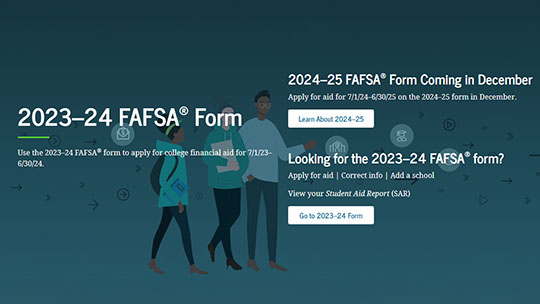enrollment
12 Strategies to Deploy While We Await the FAFSA and Subsequent ISIR Arrival
This blog was co-authored with Ann Cools.

By now we’ve all accepted that the next 60 days will be one of excitement and nervousness in the world of financial aid and enrollment management as we await the changes to the FAFSA. Some of you are well prepared; others are trying to get prepared with limited staff and even more limited resources. We feel your pain and we hope to provide a few things to have on your to-do list as you head into this delayed FAFSA season.
I don’t know about you, but I’ve looked at this delayed FAFSA season and remember the days when the application for financial aid wasn’t available until after the first of the year, Institutional Student Information Records (ISIRs) or even Student Aid Reports (SARs) didn’t arrive until March, at which point aid notifications were sent shortly thereafter. While not exactly the same, the timing this year is certainly different with FAFSAs expected to be available at the end of December. That’s followed by the receipt of ISIRs in January and the ability to correct or update those ISIRs in February. This doesn’t even include the required changes to software updates and patches still to come.
However, the delay also provides an opportunity to do some additional preparation and engage students and families. In light of that, here are a dozen things you should have on your to-do list. You will likely see a theme through this list of communication.
1. Communicate about the Federal Student Aid ID (FSA ID)
Make sure to communicate to students and families the importance of obtaining their FSA ID. It may be complicated for some families, but this is a must-do and should be done early. The Department of Education has also put out some great videos that could be wonderful resources.
Another strategy is similar to the days when FAFSA workshops were/are held—consider holding FSA ID “how to” workshops. These can be great virtual resources with some shelf life. (If anything was learned in the pandemic, it’s how to make videos.)
2. Engage parents about college planning and cost
We know that parents are important in the college planning process. If you don’t currently have a communication flow that is specifically targeted to parents, there is no better time than the present. Those messages to families should reiterate why the cost of college is worth the investment, something that more families are questioning.
3. Review your communication flows
This is important for both internal colleagues (campus leadership) as well as parents and students. Remind internal and external audiences of the delayed FAFSA, that it’s impacting all colleges and universities, and that aid is coming. You can also:
- Remind audiences about the importance of the campus visit.
- Generate excitement with your scholarship strategy and review your sequence of on-campus events as well as their intent and goals.
- Encourage internal and external audiences to view the same resources to obtain an FSA ID.
4. Launch an early aid estimator
Since the use of “prior-prior” tax information has been implemented, we have conditioned the marketplace to talk about cost and affordability earlier than ever. With the delayed FAFSA, the answers to the questions are delayed, but they are still being asked. If you do have a mechanism in place that allows you to share with families an estimated award based on current federal Student Aid Index (SAI) methodology, it may be worth investigating that lift. Realistically most aid notifications may not be in student’s hands for at least the next 90 days. This may be separate from your federally mandated net-price calculator as there are some compliance requirements for that specific calculator.
5. Use tech platforms to communicate with students and parents
There are many different platforms that “blast” out messages to students and parents (Slate Live and ZeeMee are two examples.) You may also have something internal that has messaging or text capabilities to get messages out quickly. As mentioned above, messages can include “While the timeline may be off, aid will still be coming.“
Also, do not miss the opportunity to be the institutional resource for your admit pool. I would much rather be the one talking to my student pool about this exciting change than someone from a competing institution. You want to be the one engaging in those conversations and making a case to continue toward enrollment.
6. Do your analysis on your returning students with the NAFSAA SAI tool.
Don’t be surprised by the implications the new calculation has for your campus. While the FSA ID education piece is important for students and parents, determining the financial impact is potentially the most important for you and your campus. Here are several related things you should do:
- Look for those who are currently receiving Pell but may lose that aid. What will your strategy be? Will you replace lost Pell funds with institutional resources?
- Do you have a contingency fund set aside for those continuing students who have dramatic changes to their need-based aid eligibility?
- Ensure that your families are aware of the professional judgment process.
- Understand the “sibling” impact. This has been a highly talked about topic and knowing your exposure (just like Pell) will be important.
Talk with our enrollment experts
Let’s talk about how you can find the optimal strategies for digital marketing, inquiry management, financial aid awarding, optimizing yield, and other key actions.
7. Review your awards and process for efficiency and improvements
This delay offers extra time to assess your awards and processes. Look for ways to improve timing and efficiency, as well as how you can maximize institutional financial aid resources.
8. Convey the cost of attendance (COA)
Make sure that you are not delaying setting up COAs. This can delay your ability to ensure that your net-price calculator and award notification language are ready to go, and you do not want to slow down an already delayed process.
9. Monitor your progress toward your goals
Again, do not let the FAFSA delay hold you up with tracking progress. Begin monitoring your progress toward your goals for enrollment and aid as you have done in the past.
10. Gather the creative assets you need for financial aid award videos
If you are delivering your financial aid awards in a video format, make sure you are getting all the creative pieces done now so that you can launch videos immediately. And if you are not using personalized financial aid award videos, now is a good time to see how these can really engage students about the cost conversation.
11. Prepare campus leadership for a potential slowing of deposits.
While campus leadership is in tune with many things, this is one area that should be discussed regularly and often in leadership meetings. Here are several key things to keep in mind:
- The FAFSA delay means that institutions using an early aid estimator will be best positioned to provide an “estimated” amount of aid a student may receive.
- With aid being delayed, be cautious of encouraging deposits. Without a strong deposit retention strategy, early deposits are at risk or should at least be considered at risk. There is much hope for a lower melt in this cycle.
- It’s reasonable to assume that despite reports of applications being up, deposits may lag. I tell my team all the time that no one celebrates their enrollment numbers in April. This may be the year of the “long game” where you accept lower volume earlier with more activity later…and that they may be “stickier.”
- There have been a few times in the last two decades that many campuses have needed to consider being flexible with the May 1st “deadline”. This may be another one of those times. What’s your plan?
12. Deploy activities and strategies to boost yield
Consider adding under-appreciated events such as admitted student day and pre-orientation activities back on the calendar. You need to remind students and parents why you are the best fit for them and that you are worth what you are asking them to pay. Make sure you include the “as demonstrated by” piece, though, as outcomes and ROI remain important for all.
Let us know how we can help you stay on track during this transition
This year our enrollment cycle is new to us all. If you are currently partnering with RNL please know that we are in this with you and the bench is deep should you need help. If you are not a partner, please still reach out. We have been in your seats, and we know that sometimes an ear or some advice can get you through. We would love to be able to help, so contact us and we will set up a time to talk.
